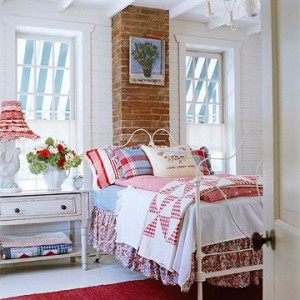 If you were to come across any vintage photo’s of bedroom interiors, you would probably be amazed at how spartan they are. The factor that would probably catch your attention before anything else is the lack of pillows that were used and the method in which they were exhibited. Most of the time there was a solitary pair of pillows that had little “loft” to them and they were normally laid flat…….not even propped up against the headboard.
If you were to come across any vintage photo’s of bedroom interiors, you would probably be amazed at how spartan they are. The factor that would probably catch your attention before anything else is the lack of pillows that were used and the method in which they were exhibited. Most of the time there was a solitary pair of pillows that had little “loft” to them and they were normally laid flat…….not even propped up against the headboard.
One of the things that is a dead give away for the way pillows were typically exhibited and used on iron beds, is that much of the interior design element on the old antique beds gets hidden with todays pillow top mattresses and large European shams and pillows.
That was not the case, back in the 1800’s. Back then, the spring unit all the beds came with was simply that……. a “spring unit”……. not a box spring as we know it today. But rather, a series of individual springs that were tied together with wire or even sometimes twine. They were famous for their noise factor and also a country full of back problems.
On top of that “spring unit” was generally a feather mattress. Some really rural places, used “horse hair” mattresses, if feather mattresses weren’t readily available.
The complete height of the “spring unit” and “feather” mattress generally didn’t exceed more than 8″ to 10″. So the interior design of a bed was made with this height in mind. Keep in mind……todays box springs alone can be 8″ to 10″. A pillow-top mattress can go as high as 25″. That’s a lot of height to have to account for. Here are two useful ways to do that so you can enjoy any original antique bed and look proportionate………use a “bunkie board” and eliminate the use of a box spring. A “bunkie board” is a 2″ thick hard foundation with no springs. That makes it 6″ less in thickness that a standard box spring. There are two benefits to utilizing a “bunkie board”……one- the elimination of 6” in height, putting the top of your mattress at a much more reasonable level. The second advantage is the better orthopedic support a hard foundation like a “bunkie board” gives, than does a box spring that does absolutely nothing other than exacerbate the amount of “flex”, spring upon spring generates.
The purpose you’re having to cope with all these measurements, and a way to use todays mattresses and massive European shams, is because the rail system that holds the mattress and box spring starts at about 13″, on all antique iron beds. On todays typical Hollywood/Harvard bed frame they are only 5″ off the ground. A difference of 8″ that has to be accounted for, so everything looks appropriate.
The second way to efficiently deal with todays tall pillows and pillow-top mattresses, is to have the headboard of your iron bed “raised”. This is a rather easy thing to have done ( any welder can do it) and it will give you a lot more display of the headboards design. It will also give you a much more “Regal” look.
After you’ve dealt with the height issues of your bed frame, you’re now ready to tackle the issue of a dust ruffle. Now here again is something that wasn’t being readily used throughout the Victorian era. Why?……….. Because back then it would have negated one of the major draws of owning iron beds. That was there effectiveness in keeping rodents out of the bed. Had dust ruffles been employed, it would have completely negated that issue. Mice can very easily climb up fabric material.
The good thing about dust ruffles is that they are adaptable to any decor or gender. Straight pleated can work best for a more tailored masculine look……. whereas heavily ruffles punch-board eyelet can give an extremely feminine romantic appeal.
When it comes to bed coverings……..well you’re on your own. Every and anything works……quilts, comforters, blankets etc. Decide your decor and the type of bed covering will become obvious. If you’d like to generate a “lush” look, use a color coordinated throw that is folded towards the foot of the bed.
The final and most essential appointment for your antique iron bed are the pillows. Here once again…..the skies the limit. For that full comfortable look, a suggestion would be to use three sets. If you have a king size bed try this….2 Large European Square Shams with two king size shams in front of the Euro’s. Then try four or five more compact throw pillows in coordinating fabrics with your comforter. The more the better. Even tailored Craftsman style can use numerous pillows and look good. The type of pillow should clearly be the same style as your decor, comforter and iron bed. Coordination of all elements, when dressing a bed will give you the “show stopper” you’re searching for. The possibilities are countless.
I hope you’ve found this blog informative . I invite you to revisit my website
to answer any and all questions you might have about antique iron beds.
I also invite you to take a look at our company Face Book page for multiple photo albums on Custom Finishes, Canopy Conversions and a comprehensive “Before & After” King Conversions album.







